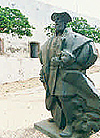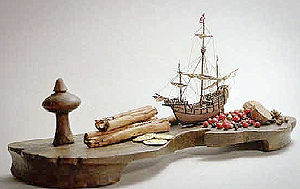 In addition to lending the expedition his most pre-eminent navigator, the sultan offered to form an alliance with the Portuguese. On April 24, they set out with the monsoon pushing them up the coast. Thanks to the abilities of their guide, they arrived on May 20, and anchored just outside the port of Calicut on the Malibar, or southwestern, coast of India 1498, after a passage of only 27 days. Small native boats were sent out to the ships to offer the Portuguese transportation to shore, but the cynical da Gama did not trust the native boatmen.
In addition to lending the expedition his most pre-eminent navigator, the sultan offered to form an alliance with the Portuguese. On April 24, they set out with the monsoon pushing them up the coast. Thanks to the abilities of their guide, they arrived on May 20, and anchored just outside the port of Calicut on the Malibar, or southwestern, coast of India 1498, after a passage of only 27 days. Small native boats were sent out to the ships to offer the Portuguese transportation to shore, but the cynical da Gama did not trust the native boatmen.
The following extract from the purported discussion, from Hart, pp. 174 ff, gives a flavor of the difficulties the Portuguese were going to have in getting their foot in the mercantile door. da Gama ordered one of the convicted criminals among his crew, João Nunes, a converted Jew who could speak both Hebrew and Arabic, to make the first trip to shore. Nunes entered one of the small native boats and was taken directly to the house of two Muslim Arabs from North Africa, who could speak Spanish and Italian.
- Vasco "Where did you come from?" the Arabs asked.
"From Portugal," said Nunes.
"The devil take you!" said the Arabs. "What brought you here?"
"We come in search of Christians and spices," Nunes said.
Although the two Arabs were clearly not pleased by the prospect of Portuguese competition, they politely offered Nunes a snack of wheat bread and honey. They admitted, "You owe thanks to God for bringing you to this rich country. You are lucky. This place has plenty of rubies, plenty of emeralds."
In view of the hindrance from these crafty Arab merchants, the ensuing negotiations with the local ruler (the samudrin raja, usually anglicized as Zamorin) were frequently violent. Ultimately da Gama was able to obtain an ambiguous letter of concession for trading rights. Unfortunately, the expedition was compelled to sail off without warning after the Zamorin insisted on his leaving behind all his goods as collateral. Da Gama kept his goods, but left behind a few Portuguese with orders to start a trading post. In view of the difficulties encountered thus far, one has to believe that those left behind were not on good terms with da Gama.
Postscript
The landing in Calicut is the beginning of a whole other story, one that will be told here merely in abbreviated form. Similarly to the story of the voyage up to this time, it is a tale embellished with scenes of embarrassment and petty squabbles, and often displays da Gama's lack of diplomacy. The rest of the story concerns the influx of Portuguese culture into India. While Portuguese culture has never dominated the Indian lifestyle, there was nonetheless an exchange of language, values, institutions, and genes that can be detected in Goa and even Calcutta to this day.
Of the 170 men who had started the voyage, only 54 lived to complete it, and the goods they brought back did not come even close to paying for the expedition. Nevertheless, upon his return to Portugal in September 1499, da Gama was richly rewarded as the man who had brought to fruition a plan that had been hatching eighty years. He was given the title "Admiral of the Indian Ocean".
 On February 12, 1502 he sailed again with a fleet of twenty warships to enforce Portuguese interests. It seems that Pedro Alvarez Cabral, who had been sent on a follow-up expedition to India two years earlier, incidentally discovering Brazil enroute, found that those Portuguese emissaries who had remained at the trading post had been murdered, and he encountered further resistance by the devious Moslem merchants, to the point that he had had to bombard Calicut with his superior fleet of thirteen ships. He also bore plenty of gifts for Calicut's hard-to-please mayor . However, after his show of force, Cabral accused the mayor of siding with the Moslems against him. Then he took his wares to two other ports, Cochin and Cannanore. He came home with only seven ships and half his men, but with enough spices, incense, porcelain and jewels to turn a handsome profit.
On February 12, 1502 he sailed again with a fleet of twenty warships to enforce Portuguese interests. It seems that Pedro Alvarez Cabral, who had been sent on a follow-up expedition to India two years earlier, incidentally discovering Brazil enroute, found that those Portuguese emissaries who had remained at the trading post had been murdered, and he encountered further resistance by the devious Moslem merchants, to the point that he had had to bombard Calicut with his superior fleet of thirteen ships. He also bore plenty of gifts for Calicut's hard-to-please mayor . However, after his show of force, Cabral accused the mayor of siding with the Moslems against him. Then he took his wares to two other ports, Cochin and Cannanore. He came home with only seven ships and half his men, but with enough spices, incense, porcelain and jewels to turn a handsome profit.
On da Gama’s 1502 mission, he assaulted and exacted tribute from the East African Arabian port of Kilwa, which had been one of the key centers obstructing Portuguese interests. Further, da Gama played the role of privateer amongst Arab merchant ships, then finally smashed a Calicut fleet of twenty-nine ships and essentially conquered that port city. In return for peace, he received valuable trade concessions and a vast quantity of plunder that stood him in extremely good staid with the Portguese crown. Returning to Portugal, he was made Count Vidigueira out of lands that had previously belonged to the royal Braganza family.
Having acquired standing as a tough problem solver when it came to India, da Gama was sent to the subcontinent once more in 1524. The intention was that he was to replace the incompetent Eduardo de Menezes as viceroy of the Portuguese possessions, but he died not long after arriving in Calicut. After burial for some time in India, his remains were returned to Portugal in 1539 and re-interred in Vidigueira.
Alfonso d'Albuquerque, whose ferocity and native-bashing made da Gama appear as a saint, arrived in 1507 with three squadrons and fortified Colchin. Meanwhile, Francisco de Almeida had been appointed the first Portuguese Viceroy in 1505. The next year in a sea battle the Portuguese massacred Muslim crews. The Portuguese maintained a military advantage at sea, because Indian ships were not strong enough to use cannons. The Egyptian sultan sent a fleet to join a Muslim alliance, and they defeated a Portuguese fleet in 1508; but the next year Viceroy Almeida devastated the Muslim fleets near Diu off the Gujurat coast. The Gujurat sultan released prisoners and allowed the Portuguese to build a fort on Diu.
Albuquerque replaced Almeida as governor in November 1509. He followed the Portuguese king's instruction to destroy Calicut and forced all ships to put in at Goa, which he conquered in 1510, killing 6,000 Muslims. He called a council to approve building a fort and encouraged the Portuguese to marry Indian wives by giving them lands, houses, and cattle. Albuquerque conquered Malacca in 1511; he failed to take the key gateway to the Red Sea at Aden in 1513 but took the trading center for the Persian Gulf at Hormuz before he died in 1515.
As much as anyone after Henry the Navigator, da Gama was responsible for Portugal's success as an early colonizing power. Besides the first voyage itself, it was his astute mix of politics and war on the other side of the world that placed Portugal in a preminent position in the Indian Ocean trade.
All of this just goes to show that, as cruel as da Gama’s exploits may have seemed, there were far worse barbarities to follow, not all of them attributable to the Portuguese. It is not a pretty story, but one that may be familiar to those following events in the modern Middle East, where the “good guys” are hard to find among the criss-crossing tank shells and Katyusha rocket volleys.
More Will the Real Vasco de Gama Please Stand Up
- Introduction
Scientific Foundations: Prince Henry The Navigator And His Disciples
Underway – Headed for the World’s Extremities
Calcutta at Last
Map: Vasco de Gama's Route (slow: 129K)
Back to Cry Havoc #39 Table of Contents
Back to Cry Havoc List of Issues
Back to MagWeb Master Magazine List
© Copyright 2002 by David W. Tschanz.
This article appears in MagWeb (Magazine Web) on the Internet World Wide Web. Other military history articles and gaming articles are available at http://www.magweb.com